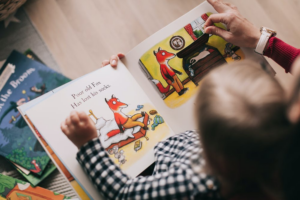How to Give Your Kids the Pre-Reading Skills They Need
 Learning to read isn’t easy, as most educators can attest, but it’s one of the most important academic skills most children will learn — and one that they’ll need to use daily for the rest of their lives. As a parent, you can take steps at home to give very young children pre-literacy skills that will prepare them to learn to read when they begin elementary education.
Learning to read isn’t easy, as most educators can attest, but it’s one of the most important academic skills most children will learn — and one that they’ll need to use daily for the rest of their lives. As a parent, you can take steps at home to give very young children pre-literacy skills that will prepare them to learn to read when they begin elementary education.
Pre-literacy skills like print motivation, print awareness, narrative skills, sequencing, letter recognition, phonological awareness, and vocabulary can lay a solid foundation on which later education can begin to build reading and writing skills. Just as they do to learn other skills, children use play and interaction with adults to develop literacy skills. Here are strategies to help your kids build on these….
Read to Your Kids
One of the best things you can do to cultivate early literacy skills in your kids is to read to them from a young age. Your kids can’t be too young to enjoy reading — research shows that even from birth, kids like being read to, and reading can strengthen the bond between parents and children from the youngest age. For example, parents who read to newborn babies in the NICU developed the same feelings of emotional closeness and intimacy with their children as those who were able to take their babies home and bond with them normally.
In addition to becoming a special bonding time between you and your child, reading time can also introduce kids to concepts like words and letters, cadencing, narrative sequencing, vocabulary, and print motivation, or the desire to read. As your children get a little bit older, from the age of one to two years, they’ll be able to follow along in the book. You should take advantage of this by pointing out parts of the book — the authors’ and illustrators’ names and the cover page, for example — and by pointing at words with your finger as you read through the book. This will help kids begin to make the connection between sounds and words or letters, known as print awareness.
Foster Their Interest in Reading
Print motivation, or interest in reading, is one of the most important literacy skills kids need, because it can inspire them to pursue reading and develop their literacy skills. You can choose some of the books you read to your kids, but you should also let them select books you’ll read together. Encourage kids to choose nonfiction books, with lots of pictures, about things that interest them, as well as works of fiction. Take kids to the library to check out books from the children’s section.
You can also play games that test their recall of books and prepare them for close reading activities later in their academic lives, as well as building narrative skills like sequencing (the ability to tell a story in the right order). Pick up second-hand copies of their favorite books at a thrift store, remove the pages from the binding, and have your child play at putting the pages back together in their correct order from memory. If this game isn’t challenging enough for your child, cut the words from the illustrations (if you can) and have your child match the correct text to the correct illustrations.
 Play Word Games with Them
Play Word Games with Them
There are plenty of word games you can play with kids to build vocabulary, letter awareness, phonological awareness, and print awareness. Begin by teaching kids to look for and recognize environmental print, like signs, logos, and symbols. Let your child cut out familiar signs, symbols, and logos from magazines and newspapers paste them into a sheaf of blank paper stapled together to make his or her own book.
Encourage your child to point out familiar signs and symbols when you’re out together. Your child may not be able to read yet, but he or she can probably recognize road signs and logos. Play word games like I Spy or word family games to teach phonological awareness and vocabulary. Make labels for common household items to inspire print awareness and vocabulary.
Develop narrative skills like sequencing by buying or printing sequencing cards. Ask your child to put the cards in order and then tell you the story that goes along with them. This can be a fun exercise. You can also cut pictures out of magazines and ask them to tell you a story about each picture. Build letter awareness by teaching your child the alphabet, helping him or her learn to make the letters, and teaching him or her which letters make up his or her own name.
Reading is a complex task that many kids will struggle with throughout their lives. To make sure your child develops strong literacy skills, start building their understanding young. With strong early literacy skills, kids can become lifelong readers who enjoy, rather than view reading as a tiresome chore.















